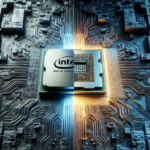How CPU Manufacturing Processes Have Evolved

Introduction
The Central Processing Unit (CPU) is often referred to as the brain of a computer. It performs the essential calculations and tasks that allow software to run. Over the decades, CPU manufacturing processes have evolved dramatically, leading to significant improvements in performance, efficiency, and capabilities. This article delves into the history and evolution of CPU manufacturing, exploring the technological advancements and innovations that have shaped the modern CPU.
The Early Days of CPU Manufacturing
The Birth of the CPU
The concept of a CPU dates back to the mid-20th century. The first general-purpose electronic computer, the ENIAC, was built in 1945. However, it wasn’t until 1971 that Intel introduced the first commercially available microprocessor, the Intel 4004. This 4-bit CPU was a groundbreaking innovation, containing 2,300 transistors and capable of performing 60,000 operations per second.
Transistor Technology
Early CPUs were built using discrete transistors, which were bulky and consumed a lot of power. The invention of the integrated circuit (IC) in the late 1950s by Jack Kilby and Robert Noyce revolutionized CPU manufacturing. ICs allowed multiple transistors to be placed on a single silicon chip, significantly reducing size and power consumption while increasing performance.
The Evolution of CPU Manufacturing Processes
Moore’s Law
In 1965, Gordon Moore, co-founder of Intel, observed that the number of transistors on a chip doubled approximately every two years. This observation, known as Moore’s Law, has been a driving force behind the rapid advancement of CPU technology. As transistor sizes have shrunk, CPUs have become more powerful and efficient.
From Micrometers to Nanometers
The early CPUs were manufactured using micrometer-scale processes. Over the years, the industry has transitioned to nanometer-scale processes. This shift has been crucial in increasing transistor density and improving performance. For example:
- 1980s: CPUs were manufactured using 1.5 to 3-micrometer processes.
- 1990s: The industry moved to sub-micrometer processes, with 0.8 to 0.25-micrometer technologies.
- 2000s: The transition to nanometer-scale processes began, with 90nm, 65nm, and 45nm technologies.
- 2010s: Further advancements led to 32nm, 22nm, 14nm, and 10nm processes.
- 2020s: The industry is now working with 7nm, 5nm, and even 3nm processes.
Photolithography
Photolithography is a critical process in CPU manufacturing. It involves using light to transfer a geometric pattern from a photomask to a light-sensitive chemical photoresist on the silicon wafer. As transistor sizes have decreased, photolithography techniques have had to evolve. Extreme Ultraviolet (EUV) lithography is the latest advancement, enabling the production of chips with features as small as 7nm and below.
FinFET and Beyond
Traditional planar transistors faced limitations as they shrank in size, leading to issues like leakage currents and reduced performance. To address these challenges, the industry adopted FinFET (Fin Field-Effect Transistor) technology. FinFET transistors have a 3D structure, which improves control over the channel and reduces leakage. This technology has been used in CPUs since the 22nm node and continues to be refined.
Looking ahead, new transistor architectures like Gate-All-Around (GAA) and nanosheet transistors are being explored to further enhance performance and efficiency.
Materials and Innovations in CPU Manufacturing
Silicon and Beyond
Silicon has been the primary material used in CPU manufacturing due to its excellent semiconductor properties. However, as the industry pushes the limits of silicon, alternative materials are being explored. These include:
- Silicon-Germanium (SiGe): Used to improve transistor performance.
- Gallium Nitride (GaN): Offers higher efficiency and performance for power transistors.
- Graphene: A promising material for future transistors due to its exceptional electrical properties.
Interconnects and Packaging
As transistors have shrunk, the interconnects (wires connecting transistors) have also had to evolve. Copper replaced aluminum as the primary interconnect material in the late 1990s due to its lower resistance. More recently, innovations like cobalt and ruthenium interconnects are being explored to further reduce resistance and improve performance.
Packaging technology has also advanced significantly. Modern CPUs use advanced packaging techniques like 3D stacking, where multiple layers of silicon are stacked vertically to increase density and performance. This approach is used in technologies like High Bandwidth Memory (HBM) and Intel’s Foveros 3D packaging.
Manufacturing Challenges and Solutions
Yield and Defects
As manufacturing processes have become more complex, maintaining high yields (the percentage of functional chips on a wafer) has become challenging. Defects can occur at various stages of manufacturing, leading to non-functional chips. To address this, manufacturers use advanced inspection and testing techniques to identify and mitigate defects.
Thermal Management
As CPUs have become more powerful, managing heat has become a critical concern. High temperatures can degrade performance and reduce the lifespan of a CPU. Innovations in thermal management include:
- Improved heat sinks and fans: Enhanced designs for better heat dissipation.
- Liquid cooling: Using liquid to transfer heat away from the CPU more efficiently.
- Thermal interface materials (TIMs): Advanced materials that improve heat transfer between the CPU and cooling solution.
Power Consumption
Reducing power consumption is essential for improving energy efficiency and extending battery life in portable devices. Techniques like dynamic voltage and frequency scaling (DVFS) allow CPUs to adjust their power usage based on workload demands. Additionally, advancements in transistor design and materials have contributed to lower power consumption.
Future Trends in CPU Manufacturing
Quantum Computing
Quantum computing represents a paradigm shift in computing technology. Unlike classical CPUs, which use bits to represent data as 0s or 1s, quantum computers use qubits, which can represent multiple states simultaneously. While still in the experimental stage, quantum computing has the potential to solve complex problems that are currently infeasible for classical computers.
Neuromorphic Computing
Neuromorphic computing aims to mimic the structure and function of the human brain. This approach involves creating specialized hardware that can perform tasks like pattern recognition and learning more efficiently than traditional CPUs. Companies like Intel and IBM are actively researching and developing neuromorphic chips.
Continued Miniaturization
The trend of shrinking transistor sizes is expected to continue, with researchers exploring technologies like atomic-scale transistors and single-electron transistors. These advancements could lead to even more powerful and efficient CPUs in the future.
FAQ
What is Moore’s Law?
Moore’s Law is an observation made by Gordon Moore in 1965, stating that the number of transistors on a chip doubles approximately every two years. This trend has driven the rapid advancement of CPU technology over the past several decades.
What is photolithography?
Photolithography is a process used in CPU manufacturing to transfer geometric patterns from a photomask to a silicon wafer using light. It is a critical step in creating the intricate structures of a CPU.
What are FinFET transistors?
FinFET (Fin Field-Effect Transistor) is a type of transistor with a 3D structure that improves control over the channel and reduces leakage currents. It has been used in CPUs since the 22nm node and offers better performance and efficiency compared to traditional planar transistors.
What materials are used in CPU manufacturing?
Silicon is the primary material used in CPU manufacturing due to its excellent semiconductor properties. Other materials like Silicon-Germanium (SiGe), Gallium Nitride (GaN), and graphene are also being explored to enhance performance and efficiency.
What is quantum computing?
Quantum computing is a new computing paradigm that uses qubits instead of classical bits. Qubits can represent multiple states simultaneously, allowing quantum computers to solve complex problems that are currently infeasible for classical computers.
Conclusion
The evolution of CPU manufacturing processes has been marked by continuous innovation and technological advancements. From the early days of discrete transistors to the modern era of nanometer-scale processes and 3D transistor architectures, the industry has made remarkable strides in improving performance, efficiency, and capabilities. As we look to the future, emerging technologies like quantum computing and neuromorphic computing promise to further revolutionize the field. The relentless pursuit of smaller, faster, and more efficient CPUs will undoubtedly continue to drive progress in computing technology for years to come.




